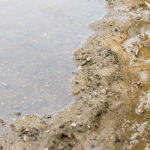Water: too much – or too little?

WATER, WATER, EVERY WHERE
And all the boards did shrink;
Water, water, every where,
Nor any drop to drink.
Some may recognize these verses from Samuel Taylor Coleridge’s “The Rime of the Ancient Mariner.” Even if one does not, it is worth noting this work, now approaching 200 years since it was written, was one of the first works advocating a more responsible use of our natural resources. The mariner’s senseless killing of an albatross leads us to question how we use and treat the fauna of this planet. Much of what is written could be applied to the flora as well.
If we remember back to this spring, days of rain created saturated soils and standing water. This did not bode well for some plants. In Coleridge’s story the sailors had no fresh water to drink, but here our trees and evergreens had more than enough fresh water, yet still could not absorb that water. Why not?

Stranded in the equatorial waters of the Pacific all but the ancient mariner eventually die from heat and lack of water.
The overabundance of water and saturation of the soil interfered with a plant’s ability to respirate and to absorb nutrients and water through its roots. The cold, wet spring also encouraged the growth of fungi, like Phytophora, in the soils which can cause lesions on the roots, which, in turn, interferes with a plant’s ability to metabolize whatever it needs. This is called root scald. At first glance some trees looked like they were wilting, in some respect they were, their roots were unable to take in nutrient and moisture causing the plant to collapse. Usually if a plant is dry leaves will wilt, turn yellow from the inner and lower branches, and the plant will begin to drop foliage to compensate.
When a plant is too wet it will begin to wilt only to have the apical branches turn reddish -brown but not separate from the plant.

How can one prepare for weather extremes? First, there is more than one way to plant a tree. Common sense goes a long way! Planting depth, the type of planting media, and choosing plants that will tolerate different soils are basic questions any landscaper should be considering for every site. It isn’t rocket science, but there is a lot more to landscaping than digging a hole and throwing the plant in!
Does the site drain well? If not, should I elevate plants in beds that will cause excessive water to run off? Choosing plants with higher metabolisms, plants with dark, more fibrous roots that can handle periodic or ephemeral flooding and including beneficial mycorrhizae in the planting media to protect root nodes will lead to transplant successes. If your planting losses are over 10%, is it due to lack of planting experience and good practices, or is your company guilty of cutting corners and careless installations? Even if you are not warranting your work, poor workmanship will catch up with any company eventually.

If heavy plant losses are “an albatross around your neck,” be a “sadder and wiser man,” and question practices and losses. Remember “the best gardeners have killed just about everything!” Becoming a more responsible contractor and pursuing best planting practices Will reduce losses and increase the bottom line. It pays to care!
“...but this I tell to thee…
He prayeth well, who loveth well
Both man and bird and beast.
He prayeth best, who loveth best
All things both great and small;
For the dear God who loveth us,
He made and loveth all.”
